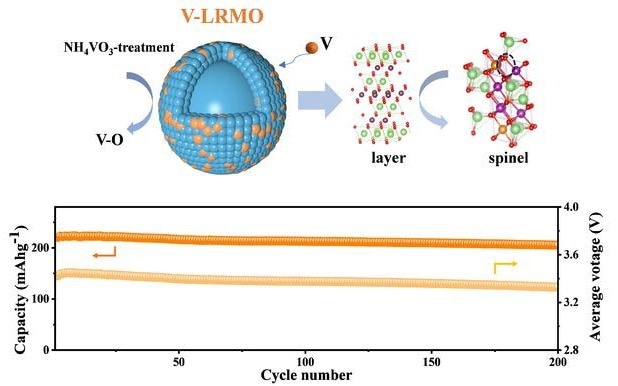Reviewed by Lexie CornerNov 11 2024
In September 2024, a significant advancement in lithium-ion battery technology was made by a team from Guangdong University of Technology, led by Dong Luo and Chenyu Liu. These findings were published in Energy Materials and Devices.
 The schematic shows the NH4VO3 treatment forming V-O bonds on a lithium-rich cathode surface, creating a V-doped spinel-layered structure. This innovation significantly improves voltage stability and boosts battery capacity, as demonstrated in the graph showing consistent performance over 200 cycles. Image Credit: Energy Materials and Devices, Tsinghua University Press
The schematic shows the NH4VO3 treatment forming V-O bonds on a lithium-rich cathode surface, creating a V-doped spinel-layered structure. This innovation significantly improves voltage stability and boosts battery capacity, as demonstrated in the graph showing consistent performance over 200 cycles. Image Credit: Energy Materials and Devices, Tsinghua University Press
As demand for energy storage devices and electric vehicles grows, lithium-ion batteries must deliver higher energy densities at lower costs. Despite their widespread use, traditional cathode materials like LiFePO4 and Li-Ni-Co-Mn-O often struggle to balance cost and performance. In contrast, lithium-rich manganese oxides (LRMOs), known for their high capacity and cobalt-free nature, have emerged as a promising alternative.
However, LRMOs have faced limitations, including rapid voltage decay and low initial Coulombic efficiency, which have hindered their widespread adoption. Further research is essential to address these challenges and stabilize LRMOs for broader commercial use.
Their study shows that applying NH4VO3 to lithium-rich cathode materials creates a vanadium-doped spinel-layered structure, enhancing voltage stability and initial Coulombic efficiency. This simple yet effective modification represents a significant advancement in improving both the performance and sustainability of high-energy lithium-ion batteries.
This study addresses two persistent challenges in LRMO cathodes: rapid voltage decay and low initial NH4VO3, resulting in a V-doped spinel-layered structure. This innovative design stabilized the oxygen redox process by enhancing lithium-ion diffusion and reducing surface interface reactions.
Interestingly, the ICE increased from 74.4 % to 91.6 %, exceeding the commercialization threshold. Along with the notable efficiency increase, the cathode also showed remarkable voltage stability, decaying only 0.47 mV per cycle over 200 cycles.
This improvement is attributed to the strong V-O bonds, which enhance the material's structural stability and inhibit irreversible oxygen release. The study presents a promising strategy for enhancing the lifespan and performance of LRMO cathodes, positioning them for high-energy applications.
Our findings offer a practical and highly effective method for tackling the persistent challenges of low Coulombic efficiency and voltage decay in lithium-rich cathodes. By incorporating vanadium, we’ve significantly improved redox stability and voltage performance, paving the way for next-generation lithium-ion batteries to meet the growing energy needs of sectors like electric vehicles and renewable energy storage.
Dong Luo, Professor, Guangdong University of Technology
Applications for the V-doped lithium-rich cathode are highly promising in consumer electronics, renewable energy systems, and electric vehicles, where battery longevity and efficiency are critical factors.
By removing cobalt, the increased stability and efficiency not only promise to reduce costs but also improve battery performance in general. As this technology grows, it could end up in more sustainable and reasonably priced energy solutions, hastening the world’s transition to cleaner, more effective power sources.
Journal Reference:
Tan, L. et. al. (2024) V-doped Co-free Li-rich layered oxide with enhanced oxygen redox reversibility for excellent voltage stability and high initial Coulombic efficiency. Energy Materials and Devices. doi.org/10.26599/EMD.2024.9370039